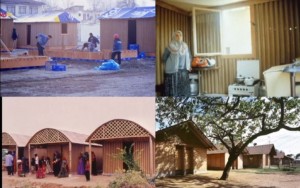 Shigeru Ban is an accomplished international architect with an interest in humanitarianism and sustainability. He is best known for his innovative work with paper, particularly recycled cardboard tubes which have been used in many countries to house disaster victims quickly and efficiently.
Shigeru Ban is an accomplished international architect with an interest in humanitarianism and sustainability. He is best known for his innovative work with paper, particularly recycled cardboard tubes which have been used in many countries to house disaster victims quickly and efficiently.
Born in Tokyo, Japan in 1957 he studied architecture in the USA and was particularly inspired by time spent studying under John Hejeduk, the most experimentally minded of the New York Five from whom he developed an interest in ‘architectonic poetics’ or the creation of three-dimensional poetry.
An important theme in his work is “invisible structure” which incorporates the structural elements as integral parts of the design.
As a Japanese architect he uses many traditional themes and methods such as shōji and the idea of a ‘universal floor’ to allow continuity between all rooms in a house. He was also one of the first Japanese architects to embrace a combination of Japanese and Western styles.
Architects, as he says in this video, traditionally work for people with money and power but he wanted to build useful structures for everyday people.
Shigeru was working on ecological and environmentally friendly ways of building long before environmental awareness became mainstream. His explorations in the use of different building materials led to much work with paper and cardboard as the basic building material. His interest in paper stems from its sustainability as a low cost, low tech, recyclable and replaceable material.
He was surprised to discover that paper was in fact far stronger than he had expected, as well as being easy to use and easy to fireproof. With these qualities in mind he developed ways to use it as a medium for creating buildings for people in disaster areas and has used it successfully in many countries and continents.
In times of disaster, building materials are limited and prices for obtaining them rise. Developing a method for building with cardboard tubing has made it far easier to source materials.
During the Rwanda crisis, the UN provided the refugees with aluminium tubing as frames for building shelters, to try and stop the deforestation that was occurring with people cutting down trees to build with.
The refugees ended up selling the aluminium for money and then reverted to cutting down trees.
Paper tubing is cheap and more versatile than tents and the community can participate in constructing their own shelters.
Shigeru often gets local students to participate in projects and help with the construction of buildings in disaster areas. For one of their buildings he chose to use beer crates as the foundation layer. The crates were donated by a Japanese beer company and Shigeru and the students thought of sending a complaint to the donor company, he says with a twinkle in his eye, when they discovered to their disappointment that the beer crates arrived empty, rather than with itinerant containers of beer intact.
In the video he talks of the various types of buildings he has designed including many refugee shelters as well as some of the churches he has built to replace those destroyed in natural disasters.


